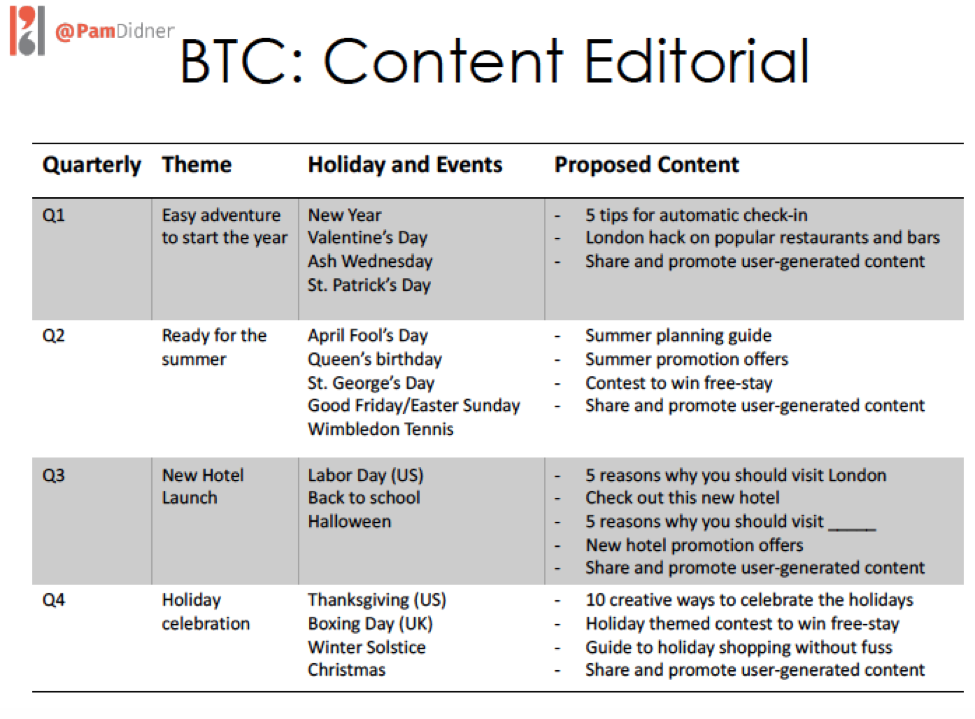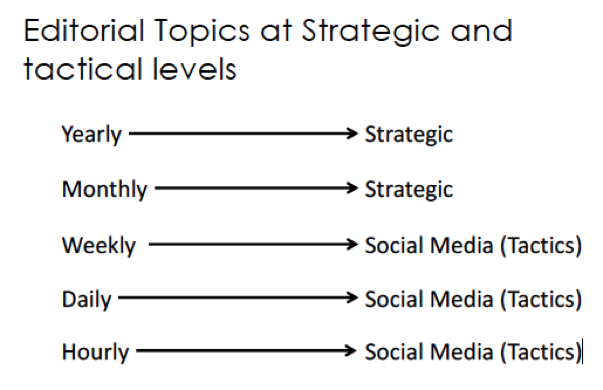- Share Maximize Synergy Between Content and Social Media Marketing on Facebook
- Share Maximize Synergy Between Content and Social Media Marketing on Twitter
- Share Maximize Synergy Between Content and Social Media Marketing on Linkedin
- Share Maximize Synergy Between Content and Social Media Marketing via email
Content marketing and social media marketing are like muffins and cupcakes. You make them similarly, the desired effect is similar, and yet—it requires a special recipe to arrange them together to create something wonderful. This post helps you understand how to create a create a special recipe (aka succinct strategy) to ensure content marketing and social media marketing work together.
What is Content Marketing?
First, the basics… I love this definition from Amanda Maksymiw of Fuze, who says content marketing can be defined as:
The process of developing and sharing relevant, valuable, and engaging content to target [an] audience with the goal of acquiring new customers or increasing business from existing customers.
See that? Developing and sharing. Content marketing isn’t just about what’s created. Content marketing is about the entire process, including the way you distribute and promote that content. Social media marketing is content marketing. It’s made of the same things: pictures, video, copy, strategy, and storytelling. The differences are the formats of content and the platforms.
The Connecting Elements Running Through Content and Social
There are four elements that apply to both content marketing and social media marketing. To succeed in your content and social media marketing strategy, you must address them in both. The four elements are:
- Objectives
- Buyers’ personas
- Product (this includes priority, messaging and value propositions)
- Editorial plan
This post addresses all four elements, and how to create a plan around them that scales for both content and social.
Aligning Objectives
Content and social have similar functions in your overall marketing strategy. Your content and social should serve one or some of these objectives:
- Help your audience understand the subject matter you specialize in
- Challenge the status quo on your subject
- Entertain your audience with content specific to them
- Educate your audience on new best practices and trends
- Convince your audience to buy your product
Your content and social shouldn’t just align with each other, they should also align with your overall business objectives. Some business objectives that your content marketing and social media can assist with include:
- Build brand equity
- Create and retain customers
- Enable sales
To turn your business goals into social media goals, I recommend first converting those goals into the marketing equivalent, then the content marketing equivalent, and finally into social media marketing. This prevents you from making big leaps from business to social media goals. It also helps illustrate the connectedness between your content and social media goals.
Translating Business Objectives to Content and Social Objectives
The business objective example:
Increase x percent of product revenue by expanding to a new segment.
The corresponding marketing objective:
Establish the product as the preferred choice for the audience that fits in the new segment by building awareness and driving demand.
The corresponding content marketing objective:
Build awareness and drive demand for the product as the preferred choice for the audience that fits in the new segment by creating and promoting relevant content to relevant channels.
The corresponding social media equivalent:
Build awareness and drive demand for the product as the as the preferred choice of the audience that fits in the new segment by creating and promoting content to relevant social media channels.
This objective is by no means a strategy. The goal is to align all departments from the business level all the way to social media. To execute this objective, or any objective in the content and social arena, first determine who your audience is and where to find them.
Who is Your Audience and Where Are They?
The first step for a content marketing or social media marketer in defining an audience is developing a buyer persona. According to HubSpot:
Buyer personas are fictional representations of your ideal customers. They are based on real data about customer demographics and online behavior, along with educated speculation about their personal histories, motivations, and concerns.
The benefits of developing buyer personas include:
- Identify with your audience
- Rally the internal and external teams
- Share a common understanding
- Drive messaging development
- Guide content creation
Here’s an example of a buyer persona by Elizabeth Gelom that might be useful to a content marketer:
Lois Lane
Demographics:
Age: 32
Occupation: Journalist/Media/Crime Reporter
Work: The Washington Post/The Marshall Project
Family: Single
Location: Washington, D.C. (travels a lot)
Archetype: The Inquisitive
Characteristics: Organized, curious, methodical, interested
Quote: “We don’t go into journalism to be popular. It is our job to seek the truth and put constant pressure on our leaders until we get answers.”

About Lois:
Lois has always wanted to be a reporter ever since she was a little girl, and started her career by becoming the editor of her high school newspaper. She went on to write for her local newspaper before going to college and then becoming a reporter for the Washington Post.
In her role as the crime reporter for The Washington Post and a freelance journalist for The Marshall Project, Lois uses Bureau of Justice Statistics (BJS) data to help support her stories. She works with analysts at Pew Research for fact checking, and often talks to local law enforcement and politicians for her stories as well.
In her free time, Lois spends time with her boyfriend who is also a journalist at The Daily Planet and a world renowned crime fighter. Lois received her undergrad degree in journalism from Columbia University in New York. She then spent three years as an intern at the New York Times before moving to Washington, D.C. to work for The Washington Post.
Her Goals:
- Break the next big story.
- Win a Pulitzer.
- To read and understand the data from xxx to help write stories that are accurate and enthralling.
Her Challenges:
• Roadblocks placed by subject matter experts, politicians, and the Department of Justice.
• Embargoed reports.
• Out of date data.
• Unreadable and hard to understand data.
Once you’ve developed an effective buyer persona, you need to create a version specifically for social media. To do this, add in additional information about where your persona exists online, which content topics they might be interested in, and the social platforms they frequent. Here’s what I’d add into the Lois Lane persona in her description:
Add the Following to “About Lois”
She wants to know about _________________________. She is always searching for _______________________.
Lois uses keyword search extensively and subscribes to numerous RSS feeds. She is on Twitter 24/7 and wants to know what’s trending and what’s happening. Her mobile phone is her BFF. Getting reliable data sources is supercritical for Lois.
Content Topics
Future Trends of ________
Challenges of implementing ________
Tips and tricks for ________
Review of __________
The impact of ________ on ____________
_________white paper

Social Media Channels (Mobile Friendly Format)
- RSS
- Keyword search and hashtags
These extra details help your social media person understand what your content person might be creating. They also give them a better idea of what platforms to focus on, how to segment their promotions, and the voice to use in their messaging.
After developing clear, well-aligned buyer personas, look at your product and determine how it fits with your persona. Ask yourself what you can do with your content and on social to make sure your proposition and messaging line up.
Value Proposition and Messaging
Focus on messaging and value propositions that help your target audience drive your business goals. You should develop a value proposition for the following areas:
- Product-specific
- Event-specific
- Discount-specific
- Editorial-topic specific
- Solution specific
Understand how your buyer persona will benefit, and what the most compelling messaging for them is depending on their persona. It could be one of, or a mix of the following:
- Monetary
- Emotional
- Productivity
- Rational
There are other benefits, but the ones listed above are the most common. Take your determinations on the benefits most important to your buyer and answer the following questions to develop your value proposition:
- Product-specific: what benefits will the reader receive if they use _______________?
- Event-specific: why do they need to attend ________?
- Discount-specific: Save ______ and be ________.
- Editorial-topic specific: They want to learn or be educated about __________ so they can ____________, _______, _________
- Solution specific: Help them solve _________ so they can ______________, _________, _________
As with all the other steps we’re taking, once you answer these questions you can create an aligned social media messaging strategy. Next, use your value proposition and messaging to develop an editorial strategy for both social and content at the same time.
Editorial Strategy
Brainstorm content topics that align with the messaging you’ve just developed. We recommend mapping the content you plan on creating through to stages of the buyer’s journey. Here’s an example for a boutique hotel in the U.K.:
There are several other places your content topic ideas can come from:
- Branding guide
- Persona (challenges, pain points, goals)
- Products and services
- Customer journeys
- Customer questions from social media channels
You should create a social editorial calendar at the same time as your content calendar. Just make sure you break your social media calendar into strategic and tactical actions.
Content scheduled in the next week should have tactical social messaging attached directly to it. Content scheduled months in advance needs only to have a strategy attached until you’re closer to publish date.
Once you’ve developed a base for keeping your social and content strategies optimized for one another, maintain it regularly to keep both strategies in alignment.
Collaborate, Collaborate, and Collaborate
Schedule out regular meetings between your social and content team to ensure everyone’s on the same page. You should hone in on the topics addressed in this blog post during each meeting. Cover objectives, personas, messaging and the editorial calendar in each meeting.
Successfully Integrating Content and Social Media Marketing
It takes effort to fully align your content marketing with your social media marketing. But once you’ve got your objectives, buyers’ personas, product, and editorial plan nailed down, it gets a lot easier. Need help getting started on your editorial calendar? Download Curata’s free Content Marketing Editorial Calendar Template.














